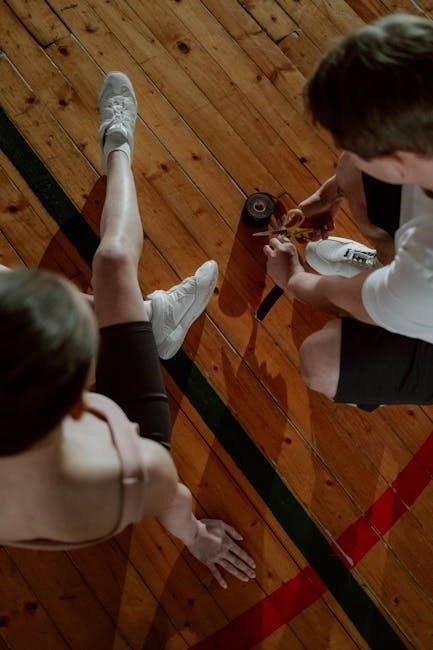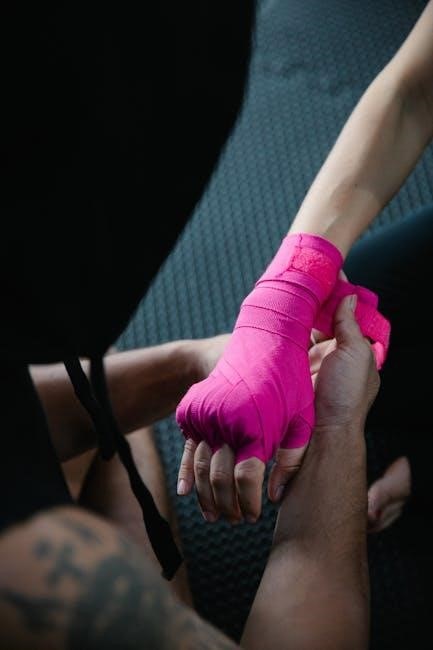
Overview of Tubular Support Bandages
Tubular support bandages are elastic‚ versatile solutions for providing compression and stability to injuries. They come in various sizes and lengths‚ making them suitable for different body parts and needs.
Tubular support bandages are elastic and versatile medical accessories designed to provide compression and stability to injured limbs. They are commonly used to treat sprains‚ strains‚ and swelling‚ as well as to offer support during post-surgical recovery. These bandages are manufactured from breathable‚ stretchable materials that allow for a full range of motion while maintaining consistent pressure. Available in various sizes and lengths‚ they cater to different body parts‚ ensuring a snug and comfortable fit. Proper sizing is crucial to avoid restricting blood flow or causing discomfort. Their elasticity enables easy application‚ and they can be reused after proper cleaning. Tubular bandages are a practical solution for both short-term and long-term support needs‚ making them a popular choice among healthcare professionals and patients alike.
Importance of Proper Sizing
Proper sizing of tubular support bandages is essential for effective support and compression. Incorrect sizing can lead to inadequate support‚ discomfort‚ or even restricted blood flow. A bandage that is too tight may cause swelling or numbness‚ while one that is too loose may fail to provide sufficient stability. Choosing the right size ensures optimal compression‚ promoting healing and reducing the risk of further injury. Properly fitted bandages also improve mobility‚ allowing patients to move comfortably during recovery. Referencing a sizing chart and measuring the widest part of the affected limb are key steps to selecting the correct size. This ensures the bandage provides the necessary support without compromising circulation or comfort. Proper sizing is crucial for achieving the desired therapeutic benefits and enhancing the overall recovery process. Always consult the size guide to ensure the best fit for the intended use.

How to Measure for Tubular Support Bandages
Measure the widest part of the limb using a flexible tape measure or size chart for accurate fitting. Proper sizing ensures effective support and compression without restricting movement.
Key Measurement Points for Limbs
When measuring for tubular support bandages‚ focus on the widest part of the limb to ensure a proper fit. For arms‚ measure the mid-bicep and mid-forearm. For legs‚ measure the mid-thigh‚ just above the knee‚ and mid-calf. For joints like wrists‚ ankles‚ knees‚ and elbows‚ measure the circumference to determine the correct size. Always consider the area requiring support and ensure the bandage is snug but not restrictive. If swelling is present‚ choose a slightly larger size. For accurate results‚ use a flexible tape measure and refer to the size chart provided by the manufacturer. Proper measurement ensures optimal compression and comfort‚ avoiding complications like impaired circulation or inadequate support. Double-check measurements to confirm the correct size before applying or cutting the bandage.
Tools Needed for Accurate Measurement
To ensure accurate measurement for tubular support bandages‚ gather the necessary tools. A flexible tape measure is essential for obtaining the circumference of the affected limb. A ruler or measuring guide can also be useful for precise length measurements. A pen or marker is needed to mark the bandage at the correct length before cutting. For optimal accuracy‚ measure on a flat surface with the limb in a neutral position. Proper lighting is crucial to see measurements clearly. If measuring someone else‚ a second person can assist in holding the tape measure steady. Avoid using rigid or inflexible tools‚ as they may not conform to the natural curves of the limb. Always refer to the size chart provided by the manufacturer to match your measurements with the appropriate bandage size. Using the right tools ensures a proper fit and effective support.

Standard Size Chart for Tubular Bandages
The standard size chart for tubular bandages offers various options to suit different limb sizes‚ from infant to adult measurements. Sizes are categorized by circumference to ensure a proper fit and optimal support.
Size A ― Infant Feet/Arms
Size A tubular bandages are specifically designed for infants‚ catering to their delicate feet and arms. With a joint circumference of 9.5-11.5cm‚ this size ensures a snug yet comfortable fit for tiny limbs. The elastic material provides gentle support and compression‚ making it ideal for sensitive skin. It is commonly used for minor sprains or to provide stability during the healing process of small injuries. The soft fabric ensures breathability‚ preventing irritation or discomfort. Proper sizing is crucial to avoid restricting movement or causing discomfort. Size A is the smallest option in the tubular bandage range‚ offering a perfect fit for newborns and young infants. It is a must-have for parents seeking a reliable solution for their little ones’ minor injuries or post-treatment care.
Size B ― Small Hands‚ Arms‚ or Legs
Size B tubular bandages are designed for small hands‚ arms‚ or legs‚ offering a perfect fit for individuals with slender limbs. This size is ideal for providing support to areas such as wrists‚ ankles‚ or smaller joints. The elastic material ensures a comfortable and secure fit‚ while the breathable fabric prevents moisture buildup. Size B is commonly used for minor injuries‚ sprains‚ or strains‚ offering the right amount of compression without restricting movement. It is also suitable for post-surgery recovery or sports injuries. The bandage is easy to apply and can be cut to the desired length for a customized fit. Size B is a versatile option for those needing light to moderate support for smaller body parts;
Size C ― Adult Hands‚ Wrists‚ and Small Arms/Legs
Size C tubular bandages are specifically designed for adult hands‚ wrists‚ and small arms or legs. This size is ideal for individuals with medium-sized limbs‚ typically measuring between 16-20cm in circumference. The elastic material provides firm support and compression‚ making it suitable for treating sprains‚ strains‚ and minor injuries. It is also commonly used for post-surgery recovery or swelling in the hands and wrists; The breathable fabric ensures comfort during extended wear‚ while the tubular design allows for easy application. Size C is a popular choice for both medical and sports-related injuries‚ offering the perfect balance of support and flexibility. It is available in various lengths‚ allowing users to cut the bandage to the desired size for a customized fit.
Size D ― Adult Arms and Legs
Size D tubular bandages are designed for adult arms and legs‚ offering support for medium to large limbs. This size is ideal for individuals with a limb circumference of 20-24cm‚ making it suitable for larger wrists‚ medium ankles‚ small elbows‚ and medium knees. The elastic material provides consistent compression‚ helping to reduce swelling and stabilize injuries. It is commonly used for sprains‚ strains‚ and post-surgical recovery. The breathable fabric ensures comfort during extended wear‚ while the tubular design allows for easy application. Size D is versatile‚ accommodating a range of needs‚ from minor injuries to ongoing support. It is available in various lengths‚ allowing users to cut the bandage to the desired size for a customized fit. This size is particularly popular for its balance of support and flexibility‚ making it a practical choice for both medical and sports-related injuries.
Size E ― Adult Legs or Small Thighs
Size E tubular bandages are tailored for adult legs or small thighs‚ providing support for areas with a circumference of 24-28cm. This size is perfect for larger ankles‚ medium knees‚ and small thighs. It offers firm compression to aid in reducing swelling and stabilizing injuries‚ making it ideal for sprains‚ strains‚ and post-operative recovery. The elastic material ensures a snug fit without restricting movement‚ while the breathable fabric promotes comfort during extended use. Size E is commonly used for sports injuries‚ offering reliable support during physical activity. It is available in various lengths‚ allowing users to cut the bandage to the desired size for a precise fit. This size strikes a balance between support and flexibility‚ making it an excellent choice for both medical and athletic needs‚ ensuring optimal comfort and effectiveness.
Size F — Adult Large Knees or Thighs
Size F tubular bandages are designed to accommodate adult large knees or thighs‚ offering support for areas with a circumference of 28-36cm. This size is ideal for larger knees‚ medium thighs‚ and similar limb sizes. The bandage provides robust compression to assist in managing swelling‚ stabilizing injuries‚ and offering post-operative support. Its elastic material ensures a secure fit‚ while the breathable fabric enhances comfort during extended wear. Size F is particularly useful for individuals with larger limbs or those requiring additional support for severe sprains‚ strains‚ or post-surgical recovery. Available in various lengths‚ it allows for customization to meet specific needs. This size is a reliable option for both medical and athletic applications‚ ensuring optimal support and comfort for larger areas‚ making it a versatile choice for various recovery and injury management scenarios.
Size G ― Adult Large Knees or Thighs

Size G tubular bandages are tailored for adult large knees or thighs‚ offering robust support for areas with a circumference of 28-36cm. This size is ideal for larger knees‚ medium thighs‚ or similar limb sizes‚ providing firm compression to manage swelling and stabilize injuries. The elastic material ensures a snug fit‚ while the breathable fabric promotes comfort during extended use; Size G is particularly suitable for individuals with larger limbs or those requiring additional support for severe sprains‚ strains‚ or post-surgical recovery. Available in various lengths‚ it allows for customization to meet specific needs. This size is a reliable option for both medical and athletic applications‚ ensuring optimal support and comfort for larger areas‚ making it a versatile choice for various recovery and injury management scenarios.
Size H, Extra-Large Limbs
Size H tubular bandages are designed to accommodate extra-large limbs‚ providing maximum support and compression for areas with a circumference exceeding 36cm. This size is ideal for larger thighs‚ calves‚ or other substantial body parts requiring robust stabilization. The elastic material ensures a secure fit‚ while the breathable fabric enhances comfort‚ making it suitable for extended use. Size H is particularly recommended for individuals with larger body frames or those recovering from severe injuries. It is also a practical choice for post-surgical recovery or managing significant swelling. Available in various lengths‚ Size H offers flexibility to meet specific needs‚ ensuring optimal support and comfort for larger areas‚ making it a reliable option for various medical and rehabilitative applications. This size is essential for providing the necessary stability and compression for extra-large limbs‚ ensuring effective recovery and injury management.

Choosing the Right Length of Tubular Bandage
Tubular bandages are available in 2-meter and 10-meter lengths. The 2-meter roll is ideal for temporary or short-term use‚ while the 10-meter roll suits larger or multiple applications.

Available Lengths and Their Uses
Tubular support bandages are available in two convenient lengths: 2 meters and 10 meters. The 2-meter bandage is ideal for temporary or short-term use‚ offering sufficient material for single applications or smaller body parts. It is perfect for treating minor injuries or providing quick support. On the other hand‚ the 10-meter bandage is designed for larger or more complex needs‚ such as wrapping multiple limbs‚ providing extended support‚ or for use in clinical settings. This longer length ensures ample coverage and flexibility for various applications. Both options are designed to deliver consistent compression and support‚ making them versatile for different scenarios. Whether for home use or professional medical settings‚ these lengths cater to a wide range of requirements‚ ensuring optimal comfort and effectiveness.
When to Use 2-Meter Bandages
The 2-meter tubular bandage is ideal for temporary or short-term use‚ offering enough material for single applications or smaller body parts. It is perfect for treating minor injuries‚ such as sprains or strains‚ and providing quick support. This length is also suitable for use on smaller limbs‚ like hands‚ wrists‚ or ankles‚ where less material is required. Additionally‚ the 2-meter bandage is convenient for emergency situations or when a rapid application is needed. Its compact size makes it easy to carry in first-aid kits or for on-the-go use. However‚ for more extensive injuries or longer-term support‚ the 10-meter bandage may be more appropriate. Always choose the length based on the specific need to ensure proper coverage and comfort.
When to Use 10-Meter Bandages
The 10-meter tubular bandage is designed for extended or multiple-use applications‚ offering ample material for larger body parts or more complex injuries. It is ideal for treating areas like thighs‚ knees‚ or legs‚ where greater coverage is required. This length is also suitable for situations needing multiple layers of compression‚ such as severe sprains or strains. Additionally‚ the 10-meter bandage is perfect for long-term support‚ allowing for repeated use without running out of material quickly. It provides sustained compression and stability‚ making it a practical choice for post-injury recovery or managing chronic conditions. For injuries requiring more extensive coverage or prolonged support‚ the 10-meter bandage is the preferred option. Always consider the severity of the injury and the duration of treatment when selecting the appropriate length for optimal results.

Application Tips for Tubular Support Bandages
Apply tubular bandages smoothly‚ starting from the distal end. Ensure the bandage is snug but not tight‚ allowing skin to breathe. Avoid bunching and follow the size guide and manufacturer’s instructions.
How to Apply a Tubular Bandage Correctly
Begin by selecting the appropriate size from the tubular support bandage size guide to ensure a proper fit. Measure the affected limb at its widest point and refer to the chart to choose the correct size. For example‚ size C is suitable for adult hands‚ wrists‚ and small arms or legs‚ while size E is ideal for adult legs or small thighs. Once the correct size is determined‚ cut the bandage to the desired length‚ typically available in 2-meter or 10-meter rolls. To apply‚ start at the distal end (farthest from the heart) and wrap smoothly‚ avoiding wrinkles. Apply even pressure‚ ensuring the bandage is snug but not overly tight to promote circulation. For added support‚ consider double-layer compression‚ especially for sprains or strains. Always follow the manufacturer’s instructions for specific application techniques. Proper application ensures optimal support and comfort‚ making tubular bandages an effective solution for various injuries and recovery needs;
When to Use Double-Layer Compression
Double-layer compression is recommended for cases requiring enhanced support and stability‚ such as severe sprains‚ strains‚ or post-surgical recovery. This method involves wrapping the tubular bandage twice over the affected area to provide additional pressure‚ which helps reduce swelling and offer firmer support. It is particularly effective for larger or more sensitive areas‚ like knees or thighs‚ where single-layer compression may not suffice. Always ensure the first layer is snug but not restrictive before applying the second layer; Double-layer compression is also useful for managing moderate to severe edema or for providing extra stability to joints during the healing process. However‚ it is important to avoid over-tightening‚ as this can impede circulation. Refer to the tubular support bandage size guide to select the appropriate size for the affected limb‚ ensuring optimal fit and comfort during double-layer application.
Common Mistakes to Avoid
When using tubular support bandages‚ it is crucial to avoid common mistakes that can compromise their effectiveness or cause discomfort. One of the most frequent errors is selecting the wrong size‚ which can lead to a bandage that is either too tight or too loose. A bandage that is too tight can restrict circulation‚ while one that is too loose may fail to provide adequate support. Another mistake is improper wrapping technique‚ such as twisting the bandage or overlapping it excessively‚ which can create uneven pressure. Additionally‚ some users forget to measure the widest part of the limb‚ leading to poor fit and reduced efficacy. Over-tightening during application is also a common issue‚ as it can cause discomfort or even restrict blood flow. To avoid these mistakes‚ always refer to the tubular support bandage size guide and ensure proper application techniques for optimal results and comfort.

Maintenance and Reuse of Tubular Bandages
Proper cleaning and storage extend the life of tubular bandages. Hand wash with mild detergent‚ avoid bleach‚ and air dry. Store in a cool‚ dry place. Replace when elasticity diminishes or fabric deteriorates.
How to Clean and Store Tubular Bandages
To maintain the quality and elasticity of tubular bandages‚ proper cleaning and storage are essential. Hand wash the bandages in warm water using a mild detergent‚ avoiding bleach or harsh chemicals. Gently agitate the water to remove dirt and stains‚ then rinse thoroughly. Allow the bandages to air dry away from direct sunlight‚ as heat can weaken the elastic fibers. Store them in a cool‚ dry place‚ folded neatly to prevent creasing or stretching. Avoid machine washing or drying‚ as this can damage the material. Regular cleaning prevents bacterial buildup‚ ensuring the bandages remain hygienic for reuse. However‚ if the bandage loses its elasticity or shows signs of wear‚ it should be replaced. Proper care extends the lifespan of tubular bandages‚ ensuring they provide consistent support and compression when needed.
When to Replace a Tubular Bandage
Knowing when to replace a tubular bandage is crucial for maintaining its effectiveness and ensuring proper support. Replace the bandage if it shows signs of wear‚ such as fraying‚ tears‚ or loss of elasticity. If the bandage becomes stretched out or no longer provides the necessary compression‚ it should be replaced immediately. Additionally‚ if the bandage becomes soiled or develops an unpleasant odor‚ it is time to replace it‚ as this can compromise hygiene. Regularly inspect the bandage for damage‚ especially after washing or prolonged use. If the bandage loses its shape or fails to conform to the limb‚ it is no longer functional. Replace it to ensure continued support and protection for the affected area. Proper replacement maintains the bandage’s effectiveness and prevents potential discomfort or further injury.

Troubleshooting Common Issues
If the bandage feels too tight‚ remove and reapply it‚ ensuring proper alignment. If too loose‚ consider using a smaller size or adding a double layer for better compression.
What to Do if the Bandage is Too Tight
If the bandage feels too tight‚ it may restrict circulation or cause discomfort. Remove it immediately and reapply it with less tension. Ensure the bandage is wrapped evenly‚ avoiding overlapping layers. Proper sizing is crucial; consult the size chart to confirm the correct fit. If tightness persists‚ consider using a larger size or adjusting the application technique. Tight bandages can lead to swelling or numbness‚ so addressing the issue promptly is essential for effective support and comfort.
What to Do if the Bandage is Too Loose

If the bandage feels too loose‚ it may not provide adequate support or compression. To address this‚ start by checking the size chart to ensure you’ve selected the correct size for the affected limb. If the bandage is too large‚ consider using a smaller size or adjusting the wrapping technique. When reapplying‚ ensure the bandage is wrapped snugly but not overly tight‚ with even pressure. Overlapping layers correctly can help maintain the desired compression. If looseness persists‚ double-layer compression might be necessary. Always follow the application guide for proper wrapping techniques. If the issue continues‚ consult a healthcare professional for assistance. Proper fit is essential for effective support and recovery.